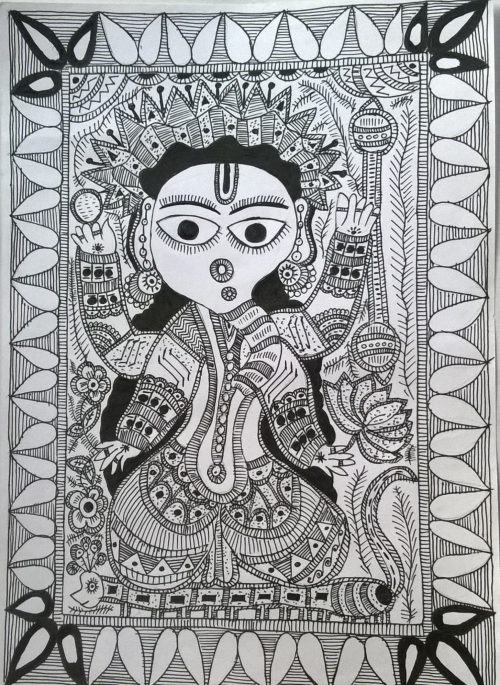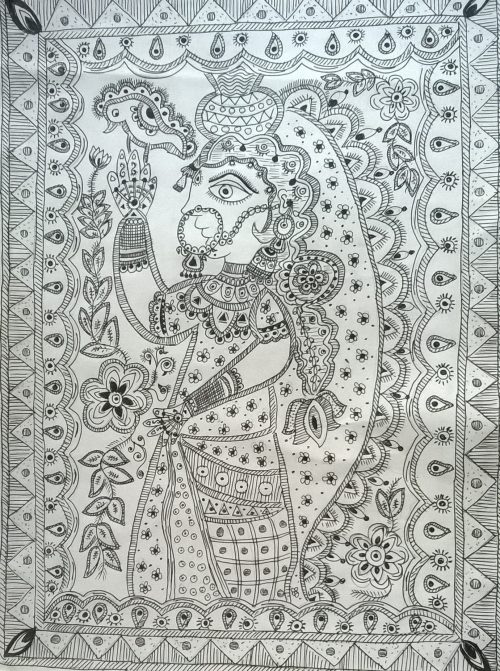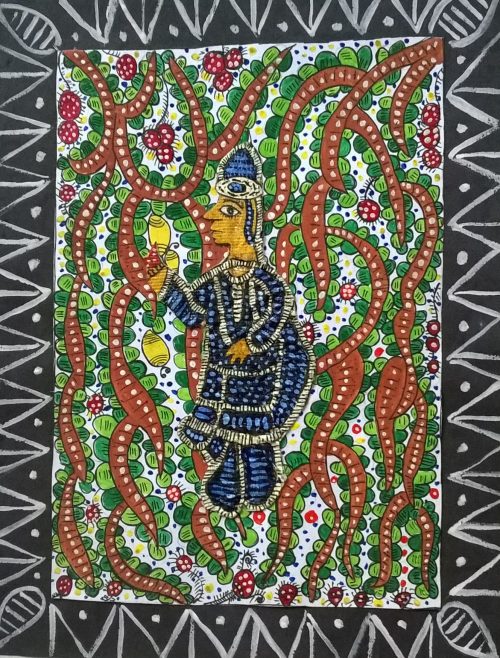MY STORY: How Learning Madhubani Painting in 10 Days Was a Life-Changing Experience for Me
I recently got trained in Madhubani painting, an art form from Bihar. Here is a brief summary of my experience on learning the traditional art.

As Sumeru is the best among mountains, Garuda among the birds, king amongst men, so is the art of painting among arts. – Chitrasutram (43-38, 39)
When multiple thoughts throng the mind regarding the way ahead, there is an innate desire in the heart to take resort in silence. And for such a silence to be blissful, many people yearn to seek refuge in art — for art is pure, divine, and blissful.

After a formal registration at South Central Zone Cultural Centre (SCZCC), I am escorted to a hall that has turned into a huge ensemble of artists from various states of India. SCZCC is an autonomous institution working under the aegis of the Ministry of Culture, and is located at Civil Lines, Nagpur. With an array of choices that make it an extremely difficult proposition, I take a lot of time in deciding which art form I want to learn. What else can you expect from a connoisseur of art especially when art forms such as Warli from Maharashtra, Phadchitra from Odisha, Pichwai Painting from Rajasthan, Mysore Gold Painting, and Mughal Art among others are bent upon luring their admirers? I finally chose to go with Madhubani painting of Bihar; something that I have always wanted to learn, probably because of the regional connects. I come from Bhagalpur.
Sheela didi and Usha didi warmly greet me. I am their pupil for the next 10 days.
Though absorbed in painting the Sita-Swayamvara episode from Ramayana, they are quick enough in their tutelage. I am asked to draw a border. Borders in Madhubani Painting can be very exquisite; though I consider Madhubani the simplest of all the art forms known to me. The reason being — it does not demand expertise from your end. An amateur can turn into a professional overnight! Proportion has no role to play here, but geometry is essential.
“Every figure has a border,” says Sheela didi as her freehand strokes create a parallel double around the figures of Ram and Sita. The origin of this art is shrouded in antiquity. According to some beliefs it was King Janaka who commissioned artists in Mithila to sketch the wedding scene of his daughter Sita. But the real credit of its discovery goes to an Englishman, William G. Archer, who came across these paintings in 1934 during earthquake relief operations. This unique art was till then unknown to the outside world because Madhubani was a secluded province.
A quick chat with Usha Devi is enough to tell me that she belongs to an accomplished family of Madhubani painters. Her mother, Shanti Devi, is a National Awardee and has travelled extensively, promoting the art both in India and abroad. Seated cross-legged on the floor is another student who I accidently chance upon. She is busy filling her hand-made paper with motifs and traditional patterns. “Didi has asked me to fill the page with leaves and flowers. No part of the sheet should remain empty,” she remarks.
Almost every painting has the background of a forest. After all, that is what Madhubani actually means — “a forest of honey”.

Legend has it that Gods and Goddess once roamed in these forests. Artists in communion with the practices of their forefathers thus depict mythology in its pristine form. Krishna-Leela, Kaliya Mardan, Gopika Sang Raas are some of their all-time favourite themes. However, Usha didi has a different taste. Bidaai or leave-taking is the most important subject for her. It is the palanquin carrying the bride that makes her so excited as the palanquin has to be given a royal look.
“The kohbar ghar is where I paint such scenes,” says Usha didi, referring to the auspicious central room of her house. Almost all the homes in Madhubani house an artist. Almost every house has walls adorned with their work.
Today, Sheela didi is going to teach how to prepare mugs, lamp-shades and jars out of papier-mache. They shall be painted in the Madhubani style once they dry up. I notice something unique about this art form — the practice of darkening outlines with black even before colouring the figures.
My hunger to know more about colours is satiated when I am told that traditional paintings are made using organic colours alone. The role of pencil, pen and sketch pen is performed by the all-rounder bamboo sticks that are dipped into jars containing a mixture of soot and water. “There is an interesting recipe to prepare primary colours” says Sheela didi. As my tutor is busy recalling the names of plants, I am amazed to discover that colours are home-made and gathered from nature — yellow from the roots of turmeric, brown from the bark of the Peepal tree, red from the crushed leaves of teak and sometimes Kusum petals. Other colours are prepared by squeezing or boiling vegetables and berries.
Grinding stones and soil also yield beautiful shades.

Tussar silk saris with a Madhubani print in the backdrop are popular among their domestic buyers. Usha didi has brought her work for display in the hope of earning some profit. “Pichchle saal jab Bombay gaye thein to loss ho gaya (We encountered losses on our previous such visit to Mumbai),” she says sadly.
One interesting fact about Madhubani art is that women in these paintings take up the centre stage here while men are in the background. Madhubani has continued to be an art form preserved mostly by women who have emerged as successful bread winners for their families with their talent to paint! These include renowned names like Ganga Devi, Sita Devi and Mahasundari Devi – all icons of Mithila Art.
With each passing day, I make certain improvements in my paintings. I am done with almost ten paintings in the Gondhna style now. Gondhna makes little use of colours and is mostly a work of muted hues. Sheela didi and Pinki didi prefer bright colours considering the economic aspect. Gondhna doesn’t sell much but a Madhubani painter will always find solace in it because it involves intricate hand work and hard work.
That is the reason why you get to see an amalgamation of both the styles today.

Another noteworthy fact about this art is the gradual shift from the genre of mythology to current societal problems. Evocative photo essays by female painters of the younger generation incorporate issues like eve-teasing. Women today depict issues concerning empowerment and peace. Once my classes end, I promise my tutors to keep the artist alive in me by preserving the heritage of Madhubani.
And true to that promise, I continue to paint Madhubani paintings whenever I get time. Hope you liked my paintings.
Featured image credits: By Sumanjha1991 (Own work) [CC BY-SA 4.0], via Wikimedia Commons, By Divya Vibha Sharma (Flickr) [CC BY-SA 2.0], via Wikimedia Commons, Flickr
Like this story? Or have something to share? Write to us: [email protected], or connect with us on Facebook and Twitter (@thebetterindia).
If you found our stories insightful, informative, or even just enjoyable, we invite you to consider making a voluntary payment to support the work we do at The Better India. Your contribution helps us continue producing quality content that educates, inspires, and drives positive change.
Choose one of the payment options below for your contribution-
By paying for the stories you value, you directly contribute to sustaining our efforts focused on making a difference in the world. Together, let’s ensure that impactful stories continue to be told and shared, enriching lives and communities alike.
Thank you for your support. Here are some frequently asked questions you might find helpful to know why you are contributing?


This story made me
-
97
-
121
-
89
-
167












